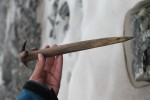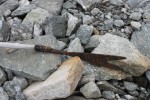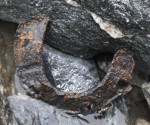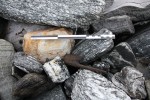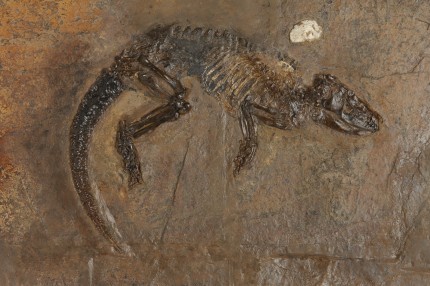
The violin played by bandmaster Wallace Hartley as
Titanic sank the night of April 14th, 1912,
has incredibly survived and was discovered in a North Yorkshire attic in 2006. Auction house
Henry Aldridge & Son announced Friday that after years of careful research and scientific analysis, they can confirm that the violin exists and is the real deal.
 The owner, who prefers to remain anonymous, found the violin in a leather luggage case monogrammed “W. H. H.” when he was rummaging through his mother’s belongings. She was an amateur musician and a letter was found inside the case written by her former teacher, a local musician and violin instructor, who gave her this inestimable treasure. Also found inside the valise were Hartley’s silver cigarette case and a signet ring.
The owner, who prefers to remain anonymous, found the violin in a leather luggage case monogrammed “W. H. H.” when he was rummaging through his mother’s belongings. She was an amateur musician and a letter was found inside the case written by her former teacher, a local musician and violin instructor, who gave her this inestimable treasure. Also found inside the valise were Hartley’s silver cigarette case and a signet ring.
 After making this crazy find, the owner contacted Henry Aldridge & Son who specialize in Titanic memorabilia. The monogrammed case, jewelry, letter and an engraved silver plate attached to the violin’s tail piece all suggested either authenticity or an impressively elaborate hoax, but as excited as they were by the prospect of having found the most important Titanic artifact to survive the sinking, involved in one of its most iconic moments — the band playing “Nearer, My God, to Thee” while the ship went down — auction house experts realized it would take a great deal of work to authentic this miraculous survival.
After making this crazy find, the owner contacted Henry Aldridge & Son who specialize in Titanic memorabilia. The monogrammed case, jewelry, letter and an engraved silver plate attached to the violin’s tail piece all suggested either authenticity or an impressively elaborate hoax, but as excited as they were by the prospect of having found the most important Titanic artifact to survive the sinking, involved in one of its most iconic moments — the band playing “Nearer, My God, to Thee” while the ship went down — auction house experts realized it would take a great deal of work to authentic this miraculous survival.
They first brought it to the UK’s Forensic Science Service, a government office which provided forensic analysis to British police and other authorities before it was closed last year due to budget cuts. The service tested the corrosion and water stains on the violin, using other artifacts that survived the wreck for comparison, and found the corrosion deposits were “compatible with immersion in sea water.” Two long cracks on the violin’s body were determined to have been caused by moisture damage.
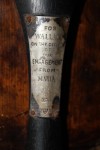 Next a jewelry expert took it in hand to examine the silver plate. The plate is inscribed “For Wallace on the occasion of our engagement from Maria.” Wallace Hartley’s fiancé was named Maria Robinson; she gave him a violin when they got engaged in 1910. The expert confirmed that the plate was original to the violin, engraved contemporaneously with the 1910 hallmarks on the panel.
Next a jewelry expert took it in hand to examine the silver plate. The plate is inscribed “For Wallace on the occasion of our engagement from Maria.” Wallace Hartley’s fiancé was named Maria Robinson; she gave him a violin when they got engaged in 1910. The expert confirmed that the plate was original to the violin, engraved contemporaneously with the 1910 hallmarks on the panel.
While the physical evidence was being put to rigorous analysis, Henry Aldridge researchers and Hartley’s biographer Christian Tennyson-Ekeburg examined to the documentary record to try to trace its path from the deck of the sinking ship to the North Yorkshire attic. According to a news account, Hartley’s body was found 10 days after the disaster by a ship called the Mackay Bennett. He was fully dressed and the instrument was strapped to his body. However, the Mackay Bennett records have an inventory of the items found on the body and the violin is not listed.
 Historians have assumed that either the news account was exaggerated/fictional or that the violin was stolen by someone after the body was found, but Maria Robinson’s diary proves that the violin was recovered and officials returned it to her. Researchers found a transcript of a telegram dated July 19, 1912, in her diary. Sent to the Provincial Secretary of Nova Scotia, the telegram read: “I would be most grateful if you could convey my heartfelt thanks to all who have made possible the return of my late fiance’s violin.”
Historians have assumed that either the news account was exaggerated/fictional or that the violin was stolen by someone after the body was found, but Maria Robinson’s diary proves that the violin was recovered and officials returned it to her. Researchers found a transcript of a telegram dated July 19, 1912, in her diary. Sent to the Provincial Secretary of Nova Scotia, the telegram read: “I would be most grateful if you could convey my heartfelt thanks to all who have made possible the return of my late fiance’s violin.”
It seems that the news story got close to the truth. His violin wasn’t strapped to his body directly, but rather Hartley put his violin in his valise (which was too small for the bow to fit) and then strapped the bag around him right before the sinking. The bag and violin may have helped keep his body floating, and since he was on his back and they were on top of his life jacket on his chest, the violin and bag were for the most part not immersed in the water. A letter from his mother found in Hartley’s breast pocket survived with almost no water damage.
Hartley’s cigarette case and signet ring were returned to his father. He gave them to Maria and she kept them together with the valise and violin as a sort of shrine to her lost beloved. She never married and died of stomach cancer at her home in Bridlington, East Yorkshire, in 1939 when she was just 59. Maria’s sister Margaret gave the valise and contents to the Bridlington Salvation Army, telling its leader Major Renwick about the incredible journey the violin had taken. Major Renwick gave it to a Salvation Army member who was a violin teacher, again passing on the Titanic story. The teacher gave it to his student, the current owner’s mother, along with a letter relaying what Major Renwick had told him.
In the early 1940s, the current owner’s mother was a member of the Womens’ Auxiliary Air Force stationed at Bridlington. She met the music teacher who later dispatched the valise and violin to her.
A covering letter that has been found states: “Major Renwick thought I would be best placed to make use of the violin but I found it virtually unplayable, doubtless due to its eventful life.”
The owner plans to eventually sell this marvel, but first he wants it to be seen by as many people as possible. It will go on display at Belfast City Hall, just a mile away from where Titanic was built, at the end of the month. They’re working on putting together an international tour after that.
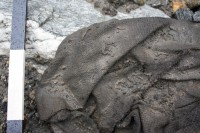 Archaeologists working on Norway’s Lendbreen glacier have found an intact woolen tunic dating to 300 A.D. The tunic is a greenish-brown now — it has darkened over the centuries — with a diamond pattern and it got a lot of use before it was discarded and swallowed up by glacial ice; there are several repaired patches. The garment was used as outerwear by a man about 5’9″ tall who for some mysterious reason took it off right next to a glacier 6,560 feet above sea level. One theory is that suffered from hypothermia which can make victims feel hot even in the middle of a freezing blizzard. Victims of hypothermia have been known to take off their clothes under the delusion that they’re hot.
Archaeologists working on Norway’s Lendbreen glacier have found an intact woolen tunic dating to 300 A.D. The tunic is a greenish-brown now — it has darkened over the centuries — with a diamond pattern and it got a lot of use before it was discarded and swallowed up by glacial ice; there are several repaired patches. The garment was used as outerwear by a man about 5’9″ tall who for some mysterious reason took it off right next to a glacier 6,560 feet above sea level. One theory is that suffered from hypothermia which can make victims feel hot even in the middle of a freezing blizzard. Victims of hypothermia have been known to take off their clothes under the delusion that they’re hot. 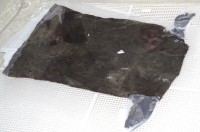 The age of the tunic was confirmed by radiocarbon dating and archaeologists believe it was left along a Roman-era trade route which stopped being used in the 4th century when the area iced over. Warming global temperatures are melting the glacier at an alarming rate, thus exposing ancient artifacts that have been trapped in ice for centuries. And so environmental disaster yet again proves itself to be a boon for archaeology, but the window for recovery of organic artifacts is very short. As soon as they are exposed to air they begin to decay, and since they’re being exposed by runoff, they go from the preserving embrace of ice to the rotting chokehold of water. Wood can take a few years to rot, but ancient textiles can be destroyed by insects and bacteria in a matter of weeks.
The age of the tunic was confirmed by radiocarbon dating and archaeologists believe it was left along a Roman-era trade route which stopped being used in the 4th century when the area iced over. Warming global temperatures are melting the glacier at an alarming rate, thus exposing ancient artifacts that have been trapped in ice for centuries. And so environmental disaster yet again proves itself to be a boon for archaeology, but the window for recovery of organic artifacts is very short. As soon as they are exposed to air they begin to decay, and since they’re being exposed by runoff, they go from the preserving embrace of ice to the rotting chokehold of water. Wood can take a few years to rot, but ancient textiles can be destroyed by insects and bacteria in a matter of weeks. 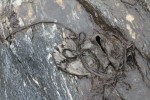 The tunic was found in 2011, but archaeologists have been exploring the glacier since 2006. They have discovered more than 1,600 ancient artifacts exposed by melting ice since then, including wooden weapons, tools and textiles. They range from a 3,000-year-old leather shoe to the remains of a 1000-year-old base camp thought to have been used by reindeer hunters. The hunters set
The tunic was found in 2011, but archaeologists have been exploring the glacier since 2006. They have discovered more than 1,600 ancient artifacts exposed by melting ice since then, including wooden weapons, tools and textiles. They range from a 3,000-year-old leather shoe to the remains of a 1000-year-old base camp thought to have been used by reindeer hunters. The hunters set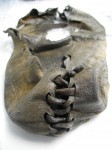 up tents on the top edge of the glacier and used the snowdrifts to trap the animals which would then be dispatched. The meat was probably processed on site and transported back to populated areas.
up tents on the top edge of the glacier and used the snowdrifts to trap the animals which would then be dispatched. The meat was probably processed on site and transported back to populated areas.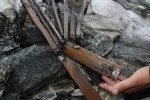 reindeer would be chased into the snowdrift traps by the sound of the scare sticks. There are artifacts that are unknown to us today whose use is a mystery.
reindeer would be chased into the snowdrift traps by the sound of the scare sticks. There are artifacts that are unknown to us today whose use is a mystery. 